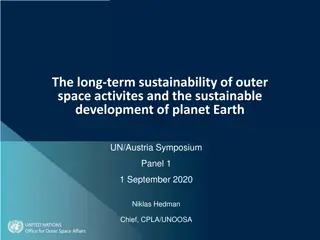Understanding the Outer Space Treaty and the Lotus Principle
The Outer Space Treaty, comprising Articles I and II, establishes regulations on the exploration and use of outer space, emphasizing the benefit of all countries and free access to celestial bodies. The Lotus Principle, illustrated by the S.S. Lotus case, highlights that actions not explicitly banned by international law are permitted. These principles govern activities in outer space, promoting cooperation and scientific investigation.
Download Presentation

Please find below an Image/Link to download the presentation.
The content on the website is provided AS IS for your information and personal use only. It may not be sold, licensed, or shared on other websites without obtaining consent from the author. Download presentation by click this link. If you encounter any issues during the download, it is possible that the publisher has removed the file from their server.
E N D
Presentation Transcript
1. The limited nature of the Outer Space Treaty 2. Articles I and II of the Outer Space Treaty 3. The Lotus Principle
Article II Outer space, including the Moon and other celestial bodies, is not subject to national appropriation by claim of sovereignty, by means of use or occupation, or by any other means. UN treaty booklet https://www.unoosa.org/oosa/oosadoc/data/documents/2017/stspace/stspace61rev.2_0.html
Article I The exploration and use of outer space, including the Moon and other celestial bodies, shall be carried out for the benefit and in the interests of all countries, irrespective of their degree of economic or scientific development, and shall be the province of all mankind. Outer space, including the Moon and other celestial bodies, shall be free for exploration and use by all States without discrimination of any kind, on a basis of equality and in accordance with international law, and there shall be free access to all areas of celestial bodies. There shall be freedom of scientific investigation in outer space, including the Moon and other celestial bodies, and States shall facilitate and encourage international cooperation in such investigation.
The Lotus Principle Whatever is not explicitly prohibited by international law is therefore permitted The Case of the S.S. Lotus, 1927 PCIJ Series A, No. 10. court- -of of- -international international- -justice/serie_A/A_10/30_Lotus_Arret.pdf justice/serie_A/A_10/30_Lotus_Arret.pdf https://www.icj https://www.icj- -cij.org/public/files/permanent cij.org/public/files/permanent- -court What is allowed in Outer Space? Oxford University Press Blog, https://blog.oup.com/2018/03/outer https://blog.oup.com/2018/03/outer- -space space- -law/ law/























